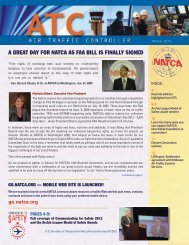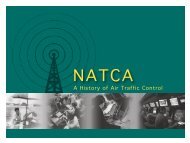Against the Wind - National Air Traffic Controllers Association
Against the Wind - National Air Traffic Controllers Association
Against the Wind - National Air Traffic Controllers Association
You also want an ePaper? Increase the reach of your titles
YUMPU automatically turns print PDFs into web optimized ePapers that Google loves.
Chapter 7<br />
The Skies Ahead<br />
When controller Archie League arrived for his day shift at Lambert<br />
Field in St. Louis, he did not don a headset. Radio communication<br />
with pilots was ano<strong>the</strong>r year off in 1929. The tools of <strong>the</strong><br />
trade for League, generally considered to be <strong>the</strong> first air traffic controller in <strong>the</strong><br />
United States, consisted of checkered and red flags, a beach chair, notepad,<br />
water, and his lunch.<br />
Every morning, <strong>the</strong> former barnstormer and<br />
mechanic piled his equipment in a wheelbarrow<br />
that he’d rigged with an umbrella to protect him<br />
from <strong>the</strong> sun. Then he trekked across <strong>the</strong> 170-acre<br />
dirt airfield, positioned himself at <strong>the</strong> approach end<br />
of <strong>the</strong> runway, and waved his flags to issue holding<br />
or landing clearances for inbound pilots.<br />
League was employed by <strong>the</strong> city of St. Louis.<br />
O<strong>the</strong>r large airports followed suit and began hiring<br />
controllers, too. However, pilots had a hard time seeing<br />
<strong>the</strong>m from above and it was nearly impossible for<br />
<strong>the</strong> controllers to simultaneously direct more than<br />
one arriving plane.<br />
Within several years, flourishing traffic<br />
forced dramatic changes. Twin-engine Boeing<br />
247D and Douglas DC-2 airliners swarmed above<br />
Chicago, Cleveland, and Newark. One airport official<br />
said as many as fifteen planes often circled<br />
overhead, “all of <strong>the</strong>m blind flying and trying to<br />
keep at a different altitude, and some of <strong>the</strong>m low<br />
on gas.” 1 Near misses occurred regularly. Local<br />
officials worried about planes crashing into neighborhoods<br />
and enacted flying restrictions around<br />
major airports.<br />
In response, Congress formed <strong>the</strong> Bureau of<br />
<strong>Air</strong> Commerce in 1934 to create and operate an<br />
air traffic control system. But <strong>the</strong> Great Depression<br />
still gripped <strong>the</strong> nation and <strong>the</strong> new agency could<br />
<strong>National</strong> Archives<br />
Newark control: Earl Ward, left, and R.A.<br />
Eccles track aircraft at <strong>the</strong> nation’s first<br />
<strong>Air</strong>way <strong>Traffic</strong> Control Unit in 1935. Ward<br />
helped to develop <strong>the</strong> concept of ATC.




